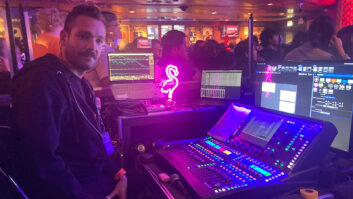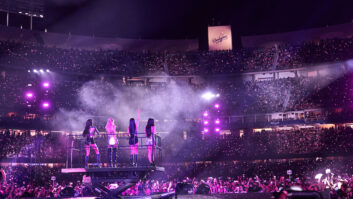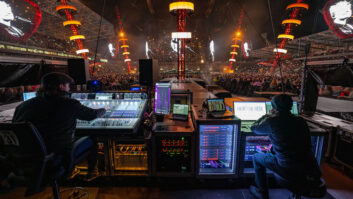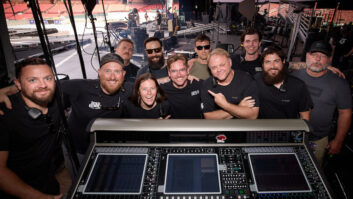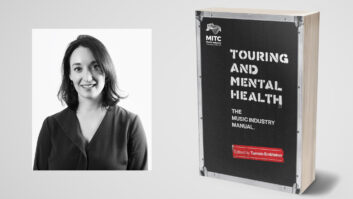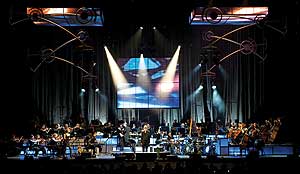
Sting performing with the London Symphonic Orchestra at Concord, Calif.’s Sleep Train Pavilion
Photos: Steve Jennings
Any consummate artist wants to up their game. Take their musical vision in a new direction. Work with new artists. Try any number of different creative avenues. Sting is that type of artist. In 2006, he teamed up with Bosnian guitarist/lutenist Edin Karamazov, releasing a fine collection in Songs From the Labyrinth. This year, Sting is hitting stages across the world with London’s celebrated Royal Philharmonic Orchestra, reimagining his classic tunes for the symphony, employing arrangers Rob Mathes, David Hartley, Nicola Tescari and Vince Mendoza to help with the transformation.
To make sure that the magic happening onstage translates effectively to each sold-out crowd, Sting turned to front-of-house engineer/Clair Global senior director of engineering Howard Page, with whom the artist has worked before, or, as Page says, “I usually do all the engineering and design of all our Clair systems and tours and then leave it to the lads, but when Sting says jump, I jump!” The two worked together during the latter part of last year, mixing various one-off shows, and “Sting insisted I be involved in this current tour.”

Front-of-house engineer Howard Page (right) and Clair systems engineer Markus Meyer.
The Clair Global–provided gear list includes a Studer Vista 5 SR at FOH, which Page finds to sound as “analog warm and pure” as any digital console he’s heard. “The almost unlimited flexibility and power in such a small footprint is a real bonus when we go into small mix areas in concert halls,” Page says. “A truly amazing advance in live sound technology! The only effects I use—or, in fact, any outboard equipment—is a TC 6000 that is digitally interfaced to the Studer. The inbuilt compressors, limiters and gates are so perfect there’s no justification to create any more in/out AD/DA conversions, which always ruins the absolute purity of the final result.”
The Studer console has also met the challenge of the number of inputs required by not only mixing for Sting, but the orchestra. Page says he’s maxing out at about 78 inputs, mainly due to the fact that he has individual clip-on mics for each and every one of the strings. Page employs what he calls the best mic he has ever heard on violins: a DPA 4099V. “For this style of show, where we are going indoors and out, they are truly a life-saver,” he enthuses. “Open overhead mics on the strings would just not work for this extremely dynamic show as all-show long, in every venue, I would be constantly up against a feedback threshold point.
“The key to mixing the orchestra is how you set up the layout of the inputs and the VCA submaster controls on the console to break down the sections of the orchestra into musically logical parts,” Page continues. “That then enables you to literally follow the arrangements within each song and sit those sections musically exactly right for each texture portion within the arrangements. Dynamics shifts can be changed on songs by creating separate masters for the group musicians, as well as the overall orchestra.”
From left: audio techs Charlie Hernandez, Sean Prickett and Stephen Carter; Clair stage engineer Pete Buess; monitor engineer Ian Newton.
Dynamics are key in this show, and Page is continually cognizant of the overall level and dynamics for each song by mixing live (i.e., no snapshots). “Sting is performing some of the most contrasting dynamic songs he has ever sung live for this tour,” he explains. “He is playing songs that he has written for albums but would never really work on the live pure-rock shows. With the orchestra, he is free to go into dynamic and emotional areas as never before. I mix the show to try to deliver each and every nuance of each and every song as Sting is creating it. This means we go whisper-quiet for some beautiful ballads and then ‘up there’ when the orchestra plays a bit of rock ’n’ roll. I try to hit the magic point where the mix and the overall levels throughout the show are exactly what the audience had in their head when they purchased their tickets.”
And that paying audience member is also the Number One priority of monitor engineer Ian Newton. To keep both the crowd and the performers onstage happy, Newton continually strives to keep the stage volume low, which is no easy feat with a combination of in-ears and wedges. “Especially with an orchestra, we’re trying to keep it down as much as we can,” Newton explains. “Some of the musicians are on in-ears—Sting’s band. We’ve got some self-powered [Yamaha] Hot Spots—a self-powered monitor on a stick—dotted throughout the orchestra just to give them a little bit of something if they need anything. And then we’ve got some wedges out onstage, but they’re working at quite a low level. Everybody’s being quite sensible about it, really. Nobody’s trying to be really loud; everybody’s playing at quite a comfortable level. When it starts getting noisy, we just bring the level down. We’re at quite a dynamic range—the stage volume depends on where you’re standing in the orchestra and what type of song Sting is singing.”
Having previously worked with Sting and The Police reunion tour, as well as Sting’s showcasing a performer with an orchestra (namely, Barbra Streisand’s latest), Newton is no stranger to this type of monitor mixing. From his PM1D (using only the onboard reverb on vocals, acoustic guitar and a couple of the woodwinds), he is giving out select mixes: “Conductor Steven Mercurio has a ‘monitor on a stick’ at his music stand, which is mainly percussion and Sting’s vocal. He also has a wedge underneath his music stand with a mere taste of bass guitar. As he’s standing in the middle of woodwinds and brass, he hears those instruments acoustically. Sting just takes a bit of orchestra—mainly strings. Apart from my cues, I don’t change anything unless they ask for them. Since we’ve started the tour, things have changed a bit, evolved a bit, but no drastic changes. Once we’re done with soundcheck, I don’t change anything apart from my cues.”
The tour is carrying a Clair i3 line array system. With its lower Q due to the wider dispersion, it’s perfectly geared toward this type of outing. Driving the system are proprietary custom-designed crossovers that match the components within the cabs as they relate to the full array. “This gives us a very real advantage over store-bought systems in that phase alignment, shading and response results are constant and predictable ‘out of the box,’” Page explains.
“Sting is one of the most wonderful guys you could ever mix sound for,” Page says. “He has been a huge star for so long that he has nothing to prove to anyone and doesn’t surround himself with people who limit access to him personally. If I want a discussion about any aspect of the audio of this show, I can go straight to him and we discuss technical matters—all to the betterment of the sound of his show; a real pleasure.”
Sarah Benzuly is
Mix
’s managing editor.



